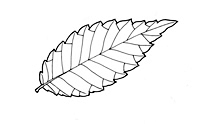Japanese zelkova
Zelkova du Japon
Zelkova serrata (Thunb.) MakUlmaceae, elm familyOrigin: Japan

Origin: Japan

Japanese zelkova is a medium-sized tree with a large spreading crown.
Read more about Tree, Bark, TwigsTwigs are brown and zig-zagged. Buds are shiny, ovoid, reddish-brown, about 0.5 cm (1/4") long, and angled at about 45 degrees to the twig. .
Leaves are narrowly oval, 3 - 5 cm (1 1/8" - 2") long, with a tapering, pointed tip and a rounded base.
Distribution
Japanese zelkova is native to Japan, Taiwan, Korea, and northeast China.
Derivation of names
The genus name Zelkova derives from the Georgian language common name of a species of zelkova native to the Caucasus. The species name, serrata, means saw-like, in reference to the leaves' toothed edges.
Commercial use
In Japan, zelkova is a valued timber tree and its wood is used to manufacture furniture and lacquerware. Japanese zelkovas may also be used as bonsai plants.
Related species
Japanese zelkova can be distinguished from elms by the shape of the leaf base and by the fruit. Elm leaves have asymmetrical bases, while zelkova leaf bases are symmetrical. Elm fruit is winged while zelkova fruit is not.
Japanese zelkova's place in the urban forest
Japanese zelkova is occasionally planted in Toronto's parks, but it is not very common. A relative of the elms, it was hoped that it could be used as a substitute for urban white elms that were lost to Dutch elm disease but this has not happened.
Landscape value and potential for home use
Since Japanese zelkova is a large tree with a spreading crown, it is only suitable for large spaces. It is fairly tolerant of pollution and drought. It grows best in deep, moist soil and can adapt to a variety of soil pH levels.
Pests and diseases: Japanese zelkova is susceptible to many of the diseases that affect elms. Black spot results in leaf spots and defoliation but is rarely fatal. Coral spot canker, which appears as lesions or cankers on the trunk and branches, may be fatal to newly transplanted trees. Japanese zelkova is resistant to Dutch elm disease as well as elm leaf beetles and Japanese beetles.
Links to maps at Canadian Tree Tours: